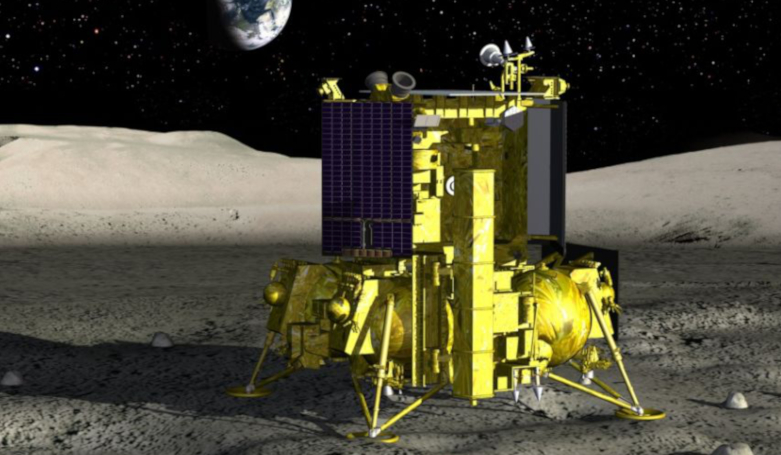Scientists at the Space Research Institute of the Russian Academy of Sciences have created a device for searching for precious metals on the Moon and Mars, that could be incorporated into either a future Russian lunar lander or be offered to other foreign landing vehicles and rovers.
The device is a prototype and has been in development for three years, says Igor Mitrofanov, head of the nuclear planetology department of the Space Research Institute, in news reported by Russian news site RIA Novosti.
“It is best suited for a lunar rover. Along the route we will be able to determine the elemental composition of the surface in a strip about 30 centimetres wide,” Mitrofanov said.
The unnamed device works by reading the energy spectra of particles that have emitted gamma radiation, with an board gamma-ray detector.
It will achieve this by first recording both the "flight" of a high-energy cosmic-ray particle, and then the gamma-photon that is emitted from the element when struck by the cosmic-ray, Mitrofanov explained.
The device is also able to distinguish between false positive signals, such as those emitted by a lunar lander, and a genuine signal from a metal-bearing lunar rock.
"We can use these observations to determine the elemental composition of matter with high accuracy. This is the idea of the device," Mitrofanov said.
Once on the surface the device will be used to search for rare earth metals such as gold, silver and platinum, at depths of several tens of centimetres to a metre.
The speed of element determination will presumably depend on the rover it is attached to. According to RIA Novosti when used on the Lunokhod, it will need to stop and stand in place for an hour or two in order to collect statistics of counts from gamma rays.
“Lunokhod-Geolog”, could be referring to Luna-27. Also called the Luna-Resurs lander, Luna-27 is a planned lunar lander mission by Roscosmos in collaboration with the European Space Agency (ESA).
The two space agency’s have recently teamed up to work on three Luna missions, two landers and one orbiter.
Luna-27, which could reach the lunar surface by 2024/2025, is being designed not just to inspect the terrain, but also to prospect it for resources such as lunar water ice in permanently shadowed regions of the Moon.
This will be a big step up from Russia’s first series of robotic lunar rovers, Lunokhod 1 and Lunokhod 2, that were first sent to the Moon in 1970.
Lunokhod 1 (which means "Moonwalker 1” in Russian) become the first roving remote-controlled robot to land on an extraterrestrial body when it landed on the lunar surface over 50 years ago.
Although only designed for a lifetime of three lunar days (approximately three Earth months), Lunokhod 1 operated on the lunar surface for eleven lunar days (321 Earth days) and traversed a total distance of 10.54 kilometres.
Its counterpart, Lunokhod 2, touched down on the lunar surface in 1973 and operated for about four months.
However, before the Luna-27 mission gets underway, Russia plans on kickstarting its new moon ambitions with Luna-25.
Luna-25 is set to demonstrate the landing technology for future missions and it will target the Boguslavsky crater near to the lunar south pole. Its flight is slated to leave from the Vostochny Cosmodrome, possibly in October 2021.
Rover missions are just the start of Russia’s new moon directive and crewed missions to the lunar surface are planned for the end of the decade.
According to Russian state media news site Radio Sputnik, Dmitry Rogozin, head of Roscosmos, announced that “a spacecraft carrying cosmonauts will fly around the moon in 2028, and their landing on the lunar surface in 2030.”
Previous statements from Russia had suggested that the 2028 launch would be carried out using a Yenisei super-heavy rocket, designed specifically for ferrying cosmonauts to the Moon.
However, the Space Council of the Russian Academy of Sciences (RAS) has recently recommended postponing the creation of Yenisei for a later date when breakthrough and economically viable technologies become available, says RIA Novosti.
Instead, several of the countries Angara-A5V carrier rockets will now be used. Manufacturing of the hydrogen stages of the A5V will start at the countries Khrunichev Center in 2024.
Commissioning of the facility, which includes the construction of two new buildings, is expected in the fourth quarter of 2023.
“This will make it possible "to create the production capacities necessary for the production of final products - the Angara-A5V launch vehicles and upper stages (Breeze-M or a heavy-class oxygen-hydrogen unit) - up to 10 products per year,” notes RIA Novosti.
Meanwhile the Russian Space Agency is busy ploughing billions of rubles into the development of the Oryol spacecraft; a crucial element of Russia's plans to land cosmonauts on the Moon.
Formerly named Federatsiya (Federation), the Oryol spacecraft (which means “Eagle”) has been in development for 10 years.
Last month, Energiya, the crafts contractors, asked Roscosmos for an additional 18 billion rubles (about $261 million) for the project.
Roscosmos chief Rogozin later clarified that part of the money was necessary to build the necessary infrastructure at Russia's Vostochny Cosmodrome.
Speaking at a press conference at the Cosmodrome just over a month ago, Rogozin said the first test launch of the new generation Oryol spacecraft is slated for August or September 2023.
If everything goes to plan, the Oryol will begin crewed test flights to the International Space Station starting in 2025.











